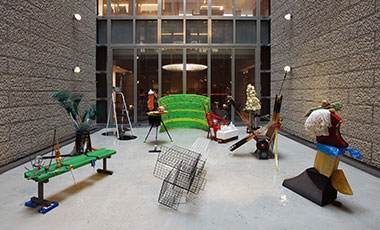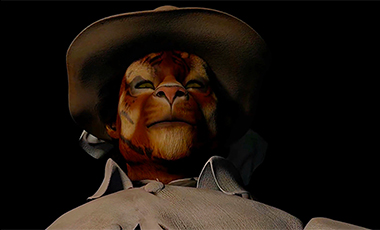Features / Review
The Literary Heart of Busan : Busan Biennale 2020, Words at an Exhibition - An Exhibition in Ten Chapters and Five Poems Review
posted 12 Nov 2020

Kwon Yongju, 〈Waterfall〉, 2020, Tarapulin, covering, Styrofoam, rubber bar, scaffolding, water pump, wood and others, 976×731.8×418cm, installation view, Yeongdo Harbor, Image Courtesy of Busan Biennale
People in Korea often call the years ending with even numbers “the biennial years.” This year, 2020, is of course one of them. Among Korea’s three largest biennials, Gwangju and Seoul postponed their openings to the next year, and only the Busan Biennaleopened as initially scheduled. Of course, these cancellations have been commonplace for many, not only for the biennales. This year, it has been hard to make a plan for the next weekend, given the strange uncertainty of the times. This has meant that large-scale exhibitions, such as biennales, have had to begin their preparatory stage at least a year before their scheduled opening dates, but the unforeseen circumstances have placed many barriers in the road to enjoying art. The preparation for the Busan Biennale was, after many twists and turns, completed in early September, yet the scheduled opening had to take place online due to Covid-19. Fortunately, however, after the biennale was half complete, the measures were lifted so that the audience could visit the venues – the Museum of Contemporary Art, Busan (MOCA Busan), the old downtown area and Yeongdo Harbor – in order to view the exhibitions.
《Pictures at an Exhibition》 (1874), composed by Russian composer Modest Mussorgsky, consists of ten piano pieces and five promenades. It describes ten paintings by Victor Heartmann (1834-1873), an artist who was a friend of the composer. Just as in the 19th century, when Musorgsky and Hartmann were alive, visual arts, sounds, and text still have an inseparable organic relationship in contemporary exhibition. Generally speaking, however, when it comes to exhibitions, the text is produced after the art work is created. The Busan Biennale 2020 started with ten short stories and five poems, all centred around the theme of the city of Busan.

Hannah Black, 〈Beginning, End, None〉, 2017, five-channel HD video, color, sound, 10 min 11 sec. Image Courtesy of Busan Biennale
The fairly straightforward exhibition title of 《Words at an Exhibition-an exhibition in Ten Chapters and Five Poems》 means that not only is the theme rather predictable, but the structural aspect of the biennale is also immediately clear. Eleven authors visited Busan to produce their own literary works, and following this corresponding works of art were placed throughout the exhibition spaces, and musicians composed new pieces of music. Regardless of genre, for many of the artists who participated in the biennale, Busan must have been an attractive place for creation. As a city that embraces the sea, Busan has been open to exchanges of people and goods from relatively early in Korean history. It was also a city where evacuees gathered from all over the country during the Korean War, and various cultures from home and from abroad have historically mixed and mingled with each other. The various levels of modernity in Busan have been fully reflected in the works of the writers, the poet and the artists participating in the biennale.

Jos de Gruyter and Harald Thys, 〈Mondo Cane〉, 2019, Animatronic sculpture (12), installation view, MOCA Busan. Image Courtesy of Busan Biennale
As soon as I entered the entrance of the MOCA Busan, which is the main exhibition venue of the biennale, I could see 〈Mondo Cane〉 (2019) by Belgian artist duo Jos de Gruyter and Harald Thys; an artwork which manifests a powerful aura. This work, which appears first in the exhibition, is reminiscent of 《iwillmedievalfutureyou1》, an exhibition curated by the Jacob Fabricius at the Art Sonje Center in Seoul last year. The exhibition, which featured narratives about the future portrayed through eccentric and dystopian contemporary fantasy, repeatedly revealed primitive and bizarre images, suggesting a form of unpredictable time travel for visitors.
In the exhibition 《Words at an Exhibition-an exhibition in Ten Chapters and Five Poems》, which features Busan's diverse layers, bizarre images and alienated subjects also stand out. Starting with works that create an uncanny atmosphere, the physical space of the MOCA Busan offers a literary experience, as though the viewers had opened the first page of a book. The works of the artists unveil alongside the short stories of Pyun Hye-young, Mark von Schlegell, Amalie Smith, Bae Suah, Yi SangWoo and Kim Soom, as well as the poems of Kim Hyesoon, which were created inspired by the theme of Busan. The writers' new fiction directly and indirectly cites the space of Busan and provides visitors with a wide range of perspectives across the past, present and future, allowing them to experience the intersecting levels of the city's reality, imagination, and history.

left Bianca Bondi, 〈The Antechamber〉, 2020, Mixed media, variable dimensions, installation view, MOCA Busan right Mandy El-sayegh, 〈What's it called? Nothing, I just collect stuff, I'm a yard man.〉, 2020, Mixed media, variable dimensions, installation view, MOCA Busan. Image Courtesy of Busan Biennale
In addition to the MOCA Busan, the old town and Yeongdo Harbour were also used as exhibition venues, allowing for more diverse viewing options. Across various spaces in the old town of Busan – Totatoga Gallery, 201, 301, Chang, Workshop, 40 steps, Space DOT, former Bank of Korea in Busan, Parking Tower, and BNK Busan Bank Art Cinema & Gallery – a combination of Busan's regional characteristics can be found in the literary works by Bak Solmay, Kim Keum Hee, and Andrés Felipe Solano, as well as in the various works by visual artists. In Yeongdo's warehouse, which was transformed into an exhibition space, the story by Kim Un-su, the works from the artists, and the space itself give synergy to each other. The various exhibition venues outside the museum spaces contain traces of the past, and of Korea's modern and contemporary history, from the opening of the port to stories of imperialism, war and refuge. Beyond the genres of visual arts and literature, I was able to enjoy the exhibitions as if I were an observer or explorer within a huge story told by the city itself.

left Francesc Ruiz 〈A Room of One's Own Lily Indie Press〉, 2020, Site-specific installation, variable dimensions, installation view, Chang right Ram Ham's atypical shaped light pannel installed on the fence of the former National Bank of Korea. Image Courtesy of Busan Biennale
This year, there have been many restrictions on physical experiences of all kinds. Therefore, the Busan Biennale 2020 must have come as a very welcome exhibition for art lovers, as well as for artists and art professionals, who have been long awaiting such an exhibition. At a time when art exhibitions, biennales and art fairs have been replaced by online viewing rooms, and when the thirst for the experience of seeing, listening and feeling real artworks has only been amplified, the Busan Biennale overcame many difficulties and finally opened its curtains. Above all, 《Words at an Exhibition-an exhibition in Ten Chapters and Five Poems》 offered an experience of traveling through Busan via literature, art, music and walking tours. The strategic approach towards merging the fine arts, culture and the creative industries has worked out positively. Now that people around the world are finding it so much more difficult to travel, I think that more attention will be focused on locality than ever before. The Busan Biennale has made the area of "Busan," which is so familiar to us, a new city of attractive impressions through the language of the arts.

Kim Heecheon, 〈A Drill〉, 2020, Banner installation, 1500x700cm Image Courtesy of Busan Biennale
Related Articles
Preview of Busan Biennale 2020 : Conversation with Artistic Director (part. 1)
Preview of Busan Biennale 2020 : Conversation with Artistic Director (part. 2)
Jiwon Lee
Jiwon Lee is editor of TheArtro. She studied Art Theory and Curatorial Studies ; Worked as a curatorial team member at Gyeonggi Museum of Modern Art, Art Space Pool and many other Contemporary Art Institutions. ; and authored, inter alia, “A Study of Hae-gue Yang’s Work on ‘Community’ and ‘Historical Reference.’” and "How Contemporary Art Remembers History"


